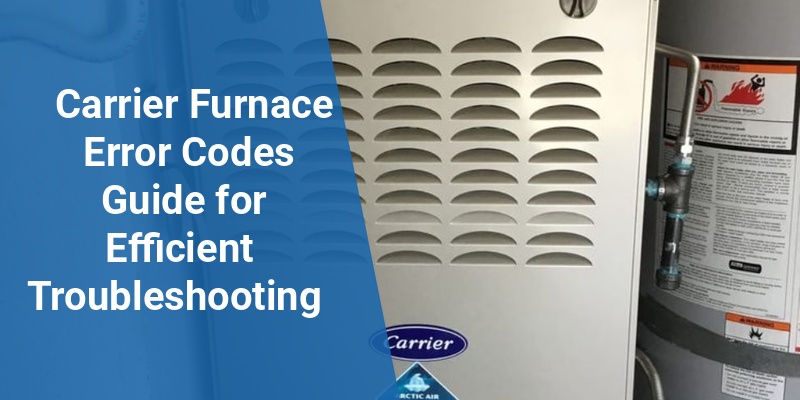Carrier furnaces are known for their quality and reliability; however, like all HVAC systems, they can encounter issues that trigger error codes. These error codes are essential diagnostic tools that help homeowners and technicians identify specific problems quickly. Understanding Carrier furnace error codes enables timely and effective troubleshooting, ensuring your heating system operates smoothly and safely.
| Error Code | Indicator | Possible Cause | Suggested Action |
|---|---|---|---|
| 1 Flash | Ignition Failure | Pilot not lighting or flame sensor issue | Check ignition system and clean/replace flame sensor |
| 2 Flashes | Pressure Switch Open | Blocked vent or faulty pressure switch | Inspect venting and replace pressure switch if needed |
| 3 Flashes | Flame Lost | Intermittent flame or defective flame sensor | Inspect flame sensor and ignition system |
| 4 Flashes | Limit Switch Open | Overheating due to airflow restriction | Check air filters and blower operation |
| 5 Flashes | Pressure Switch Stuck Closed | Obstructed venting or shorted pressure switch | Clear vent blockages and test pressure switch |
| 6 Flashes | Open High Limit Switch | Overheat condition due to flame rollout or airflow issues | Inspect heat exchanger and airflow components |
What Are Carrier Furnace Error Codes?
Carrier furnace error codes are indicator signals, usually represented by flashing LED lights on the furnace control board. These codes alert users and HVAC professionals about specific malfunctions. Each code corresponds to a unique fault, assisting in the swift diagnosis of issues ranging from ignition problems to airflow complications.
How to Read and Interpret Carrier Furnace Error Codes
Carrier furnaces often use a system where the furnace’s LED blinks in a certain pattern to indicate error codes. Counting the number of flashes followed by a pause gives insight into the specific fault. It’s important to reference the furnace’s manual or consult Carrier’s official documentation for exact definitions, as code meanings can vary slightly across models.
Commonly, a sequence of one to six flashes corresponds to different diagnostic messages. After reading the flashes, users should compare them against the error code chart for their model to determine the fault’s nature.
Common Carrier Furnace Error Codes and Their Meanings
Ignition Failure (1 Flash)
This code typically means the furnace tried but failed to ignite the burners. Causes might include dirty burners, faulty igniters, or a malfunctioning flame sensor. Inspecting and cleaning the ignition components or replacing defective parts often resolves this issue.
Pressure Switch Errors (2 & 5 Flashes)
The pressure switch verifies if the inducer motor is operating correctly and if flue gases vent properly. Pressure switch open (2 flashes) often suggests vent blockage or a defective switch, while pressure switch stuck closed (5 flashes) may indicate a switch short or blockage in the vent pipe.
Checking vent pipes for obstructions and testing the pressure switch’s continuity is crucial for correction.
Call 888-906-9139 for Free Local HVAC Quotes – No Obligation, Just Savings!
Flame Lost During Operation (3 Flashes)
This error signals the furnace flame was detected but then lost, pointing to flame sensor issues, low gas pressure, or unstable ignition. Cleaning the flame sensor is a common first step, along with checking gas supply and pressure.
Limit Switch Problems (4 & 6 Flashes)
The limit switch monitors furnace temperature to prevent overheating. 4 flashes usually indicate an open limit switch caused by restricted airflow or dirty filters, while 6 flashes point to an open high limit switch, often due to flame rollout or serious airflow blockages. Regular maintenance of air filters and blower fans is essential to prevent these errors.
How to Reset Your Carrier Furnace After an Error
For many Carrier furnaces, an error code reset involves either pressing a reset button on the control board or turning off the power to the furnace for a few minutes. However, resetting should only be done after addressing the root cause of the error to avoid recurring problems.
Repeated resets without repairs can stress furnace components and pose safety risks. If unsure, consult a licensed HVAC technician.
Preventative Maintenance to Avoid Carrier Furnace Error Codes
- Regularly Replace or Clean Air Filters: Prevents airflow restrictions that cause overheating and limit switch errors.
- Inspect and Clean Flame Sensors: Ensures reliable flame detection and ignition.
- Check Venting and Pressure Switches: Keeps exhaust pathways clear and pressure switches functional.
- Schedule Annual Professional Inspections: Identifies potential issues early and ensures efficient operation.
Implementing a maintenance routine helps reduce the frequency of error codes and prolongs furnace lifespan.
When to Call a Professional HVAC Technician
While some minor troubleshooting can be done by homeowners, many error codes require expert attention. If the furnace displays persistent error codes after basic checks or resetting, professional diagnosis is recommended. Professionals can perform advanced testing, replace complex components, and ensure safe repairs.
Typical scenarios warranting professional service include:
Call 888-906-9139 for Free Local HVAC Quotes – No Obligation, Just Savings!
- Continuous ignition failure despite cleaning
- Pressure switch issues after vent cleaning
- Limit switch errors related to suspected airflow or heat exchanger issues
- Gas pressure concerns
Summary Table of Carrier Furnace Error Codes and Key Actions
| Error Code | Description | Probable Cause | Recommended Action |
|---|---|---|---|
| 1 Flash | Ignition Failure | Dirty igniter, faulty flame sensor | Clean/replace ignition components |
| 2 Flashes | Pressure Switch Open | Blocked vent, defective pressure switch | Clear vent, test switch |
| 3 Flashes | Flame Lost | Faulty flame sensor, low gas pressure | Clean sensor, check gas supply |
| 4 Flashes | Open Limit Switch | Restricted airflow, dirty filters | Replace filters, check blower |
| 5 Flashes | Pressure Switch Stuck Closed | Blocked vent, shorted pressure switch | Clear vent, test/replace switch |
| 6 Flashes | Open High Limit Switch | Overheat, flame rollout | Inspect heat exchanger, airflow |
